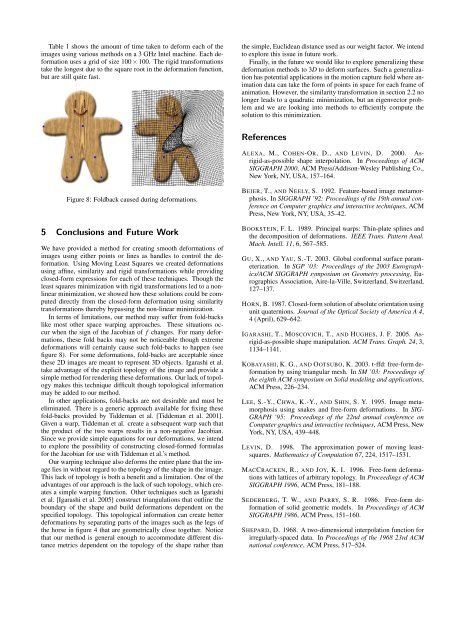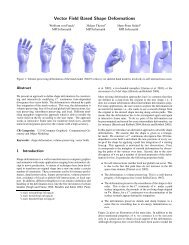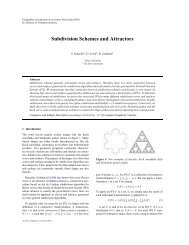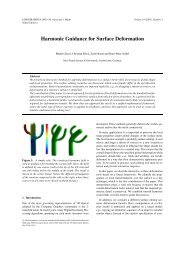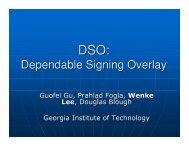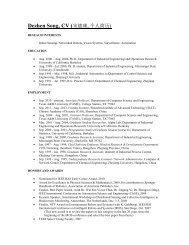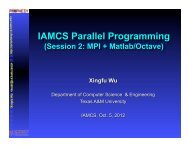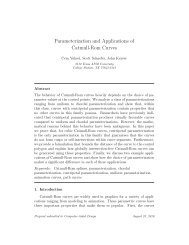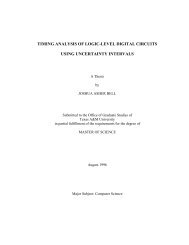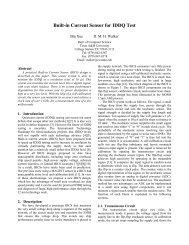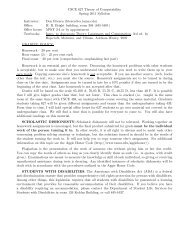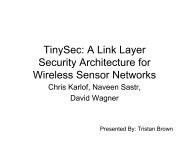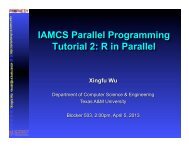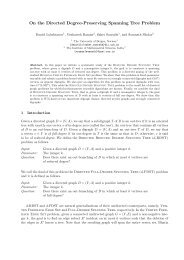Image Deformation Using Moving Least Squares - TAMU Computer ...
Image Deformation Using Moving Least Squares - TAMU Computer ...
Image Deformation Using Moving Least Squares - TAMU Computer ...
- No tags were found...
Create successful ePaper yourself
Turn your PDF publications into a flip-book with our unique Google optimized e-Paper software.
Table 1 shows the amount of time taken to deform each of theimages using various methods on a 3 GHz Intel machine. Each deformationuses a grid of size 100×100. The rigid transformationstake the longest due to the square root in the deformation function,but are still quite fast.the simple, Euclidean distance used as our weight factor. We intendto explore this issue in future work.Finally, in the future we would like to explore generalizing thesedeformation methods to 3D to deform surfaces. Such a generalizationhas potential applications in the motion capture field where animationdata can take the form of points in space for each frame ofanimation. However, the similarity transformation in section 2.2 nolonger leads to a quadratic minimization, but an eigenvector problemand we are looking into methods to efficiently compute thesolution to this minimization.ReferencesALEXA, M., COHEN-OR, D., AND LEVIN, D. 2000. Asrigid-as-possibleshape interpolation. In Proceedings of ACMSIGGRAPH 2000, ACM Press/Addison-Wesley Publishing Co.,New York, NY, USA, 157–164.Figure 8: Foldback caused during deformations.5 Conclusions and Future WorkWe have provided a method for creating smooth deformations ofimages using either points or lines as handles to control the deformation.<strong>Using</strong> <strong>Moving</strong> <strong>Least</strong> <strong>Squares</strong> we created deformationsusing affine, similarity and rigid transformations while providingclosed-form expressions for each of these techniques. Though theleast squares minimization with rigid transformations led to a nonlinearminimization, we showed how these solutions could be computeddirectly from the closed-form deformation using similaritytransformations thereby bypassing the non-linear minimization.In terms of limitations, our method may suffer from fold-backslike most other space warping approaches. These situations occurwhen the sign of the Jacobian of f changes. For many deformations,these fold backs may not be noticeable though extremedeformations will certainly cause such fold-backs to happen (seefigure 8). For some deformations, fold-backs are acceptable sincethese 2D images are meant to represent 3D objects. Igarashi et al.take advantage of the explicit topology of the image and provide asimple method for rendering these deformations. Our lack of topologymakes this technique difficult though topological informationmay be added to our method.In other applications, fold-backs are not desirable and must beeliminated. There is a generic approach available for fixing thesefold-backs provided by Tiddeman et al. [Tiddeman et al. 2001].Given a warp, Tiddeman et al. create a subsequent warp such thatthe product of the two warps results in a non-negative Jacobian.Since we provide simple equations for our deformations, we intendto explore the possibility of constructing closed-formed formulasfor the Jacobian for use with Tiddeman et al.’s method.Our warping technique also deforms the entire plane that the imagelies in without regard to the topology of the shape in the image.This lack of topology is both a benefit and a limitation. One of theadvantages of our approach is the lack of such topology, which createsa simple warping function. Other techniques such as Igarashiet al. [Igarashi et al. 2005] construct triangulations that outline theboundary of the shape and build deformations dependent on thespecified topology. This topological information can create betterdeformations by separating parts of the images such as the legs ofthe horse in figure 4 that are geometrically close together. Noticethat our method is general enough to accommodate different distancemetrics dependent on the topology of the shape rather thanBEIER, T., AND NEELY, S. 1992. Feature-based image metamorphosis.In SIGGRAPH ’92: Proceedings of the 19th annual conferenceon <strong>Computer</strong> graphics and interactive techniques, ACMPress, New York, NY, USA, 35–42.BOOKSTEIN, F. L. 1989. Principal warps: Thin-plate splines andthe decomposition of deformations. IEEE Trans. Pattern Anal.Mach. Intell. 11, 6, 567–585.GU, X., AND YAU, S.-T. 2003. Global conformal surface parameterization.In SGP ’03: Proceedings of the 2003 Eurographics/ACMSIGGRAPH symposium on Geometry processing, EurographicsAssociation, Aire-la-Ville, Switzerland, Switzerland,127–137.HORN, B. 1987. Closed-form solution of absolute orientation usingunit quaternions. Journal of the Optical Society of America A 4,4 (April), 629–642.IGARASHI, T., MOSCOVICH, T., AND HUGHES, J. F. 2005. Asrigid-as-possibleshape manipulation. ACM Trans. Graph. 24, 3,1134–1141.KOBAYASHI, K. G., AND OOTSUBO, K. 2003. t-ffd: free-form deformationby using triangular mesh. In SM ’03: Proceedings ofthe eighth ACM symposium on Solid modeling and applications,ACM Press, 226–234.LEE, S.-Y., CHWA, K.-Y., AND SHIN, S. Y. 1995. <strong>Image</strong> metamorphosisusing snakes and free-form deformations. In SIG-GRAPH ’95: Proceedings of the 22nd annual conference on<strong>Computer</strong> graphics and interactive techniques, ACM Press, NewYork, NY, USA, 439–448.LEVIN, D. 1998. The approximation power of moving leastsquares.Mathematics of Computation 67, 224, 1517–1531.MACCRACKEN, R., AND JOY, K. I. 1996. Free-form deformationswith lattices of arbitrary topology. In Proceedings of ACMSIGGRAPH 1996, ACM Press, 181–188.SEDERBERG, T. W., AND PARRY, S. R. 1986. Free-form deformationof solid geometric models. In Proceedings of ACMSIGGRAPH 1986, ACM Press, 151–160.SHEPARD, D. 1968. A two-dimensional interpolation function forirregularly-spaced data. In Proceedings of the 1968 23rd ACMnational conference, ACM Press, 517–524.


